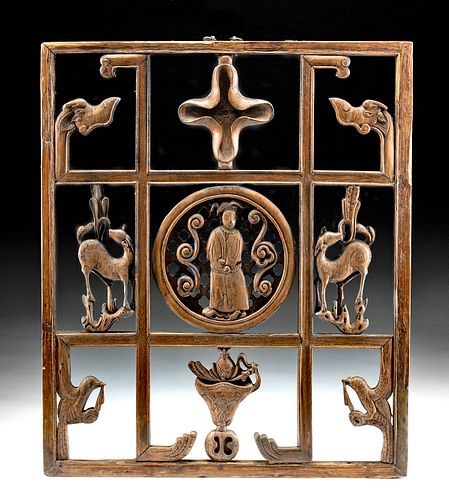18th C. Chinese Qing Wood Panel w/ Noble Woman
Lot 69d
About Seller
Artemis Fine Arts
686 S Taylor Ave, Ste 106
Louisville, CO 80027
United States
Selling antiquities, ancient and ethnographic art online since 1993, Artemis Gallery specializes in Classical Antiquities (Egyptian, Greek, Roman, Near Eastern), Asian, Pre-Columbian, African / Tribal / Oceanographic art. Our extensive inventory includes pottery, stone, metal, wood, glass and textil...Read more
Categories
Estimate:
$2,800 - $4,200
Absentee vs Live bid
Two ways to bid:
- Leave a max absentee bid and the platform will bid on your behalf up to your maximum bid during the live auction.
- Bid live during the auction and your bids will be submitted real-time to the auctioneer.
Bid Increments
| Price | Bid Increment |
|---|---|
| $0 | $25 |
| $300 | $50 |
| $1,000 | $100 |
| $2,000 | $250 |
| $5,000 | $500 |
| $10,000 | $1,000 |
| $20,000 | $2,500 |
| $50,000 | $5,000 |
| $100,000 | $10,000 |
| $200,000 | $20,000 |
About Auction
By Artemis Fine Arts
Dec 2, 2021
Set Reminder
2021-12-02 10:00:00
2021-12-02 10:00:00
America/New_York
Bidsquare
Bidsquare : Fine Antiquities | Asian | Ethnographic Art
https://www.bidsquare.com/auctions/artemis-gallery/fine-antiquities-asian-ethnographic-art-7918
Features classical antiquities, ancient and ethnographic art from cultures encompassing the globe. Egyptian, Greek, Roman, Etruscan, Near Eastern, Asian, Pre-Columbian, Native American, African / Tribal, Oceanic, Spanish Colonial, Russian, Fine / Visual Arts, so much more! Artemis Fine Arts info@artemisfinearts.com
Features classical antiquities, ancient and ethnographic art from cultures encompassing the globe. Egyptian, Greek, Roman, Etruscan, Near Eastern, Asian, Pre-Columbian, Native American, African / Tribal, Oceanic, Spanish Colonial, Russian, Fine / Visual Arts, so much more! Artemis Fine Arts info@artemisfinearts.com
- Lot Description
East Asia, China, Qing Dynasty, ca. 18th to 19th century CE. A beautiful hand-carved, openwork wood screen presenting a rectangular form resembling a window divided into 9 sections, each adorned with an elaborate zoomorphic, anthropomorphic, and phytomorphic decoration. Largest of the sections, the center of the piece is adorned with a roundel featuring a noble woman. The elegant woman gazes forward from almond-shaped eyes, as she stands before an intricate lattice pattern holding a lengthy implement in her right hand and grasping the belt of her floor-length robe with her left. Her minimalist visage is crowned by an elaborate coiffure, while cloud-like spirals lie at both her sides. In the other sections, a pair of floral motifs - perhaps intended as lotus flowers - are featured above and below the roundel and the sections to the sides, each display a dancing horse. Size without hook: 23" W x 27.5" H (58.4 cm x 69.8 cm); Size with hook: 23" W x 29.3" H (58.4 cm x 74.4 cm)
The top corners are decorated with the stylized heads of dragons. Last, the bottom 2 corners are filled with flying birds holding branches in their beaks. A metal loop is featured at the top of the piece, allowing it to be suspended for display.
This elegant carving is not only replete with artistic virtuosity, but also iconographic meaning. First, dragons have traditionally symbolized auspicious powers involving control over rainfall, water, floods, and typhoons - quite apropos for the iconography of a window screen, as windows provide both a view of and protection from the elements. Though dragons represent evil in the West, in the East, dragons are mythological symbols of good luck, strength, and power as well as the seasonal cycles and the supernatural. The horse is another significant Chinese symbol, as the animal was believed to play an important role in the Chinese Empire by enabling the ancients to communicate to parties near and far due to the great speed of these noble steeds. Additionally, the horse also assisted the military to conquer distant lands and grow the empire. As the desire for stronger, faster breeds grew, the ancients imported horses from Central Asia, leading to the creation of the famous Silk Road.
Provenance: private Hawaii, USA collection; ex-M. Kobiashi collection, Hawaii, USA, 1960 to 2000
All items legal to buy/sell under U.S. Statute covering cultural patrimony Code 2600, CHAPTER 14, and are guaranteed to be as described or your money back.
A Certificate of Authenticity will accompany all winning bids.
PLEASE NOTE: Due to recent increases of shipments being seized by Australian & German customs (even for items with pre-UNESCO provenance), we will no longer ship most antiquities and ancient Chinese art to Australia & Germany. For categories of items that are acceptable to ship to Australia or Germany, please contact us directly or work with your local customs brokerage firm.
Display stands not described as included/custom in the item description are for photography purposes only and will not be included with the item upon shipping.
#168420Some minor loosening of construction in upper corners. Expected nicks, chips, and abrasions, commensurate with age. Otherwise, intact and excellent with lovely patina.Condition
- Shipping Info
-
All shipping is handled in-house for your convenience. Your invoice from Artemis Gallery will include shipping calculation instructions. If in doubt, please inquire BEFORE bidding for estimated shipping costs for individual items.
-
- Buyer's Premium



 EUR
EUR CAD
CAD AUD
AUD GBP
GBP MXN
MXN HKD
HKD CNY
CNY MYR
MYR SEK
SEK SGD
SGD CHF
CHF THB
THB













